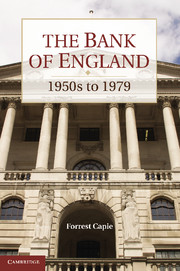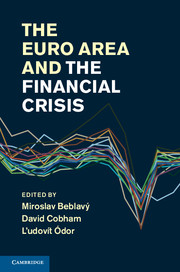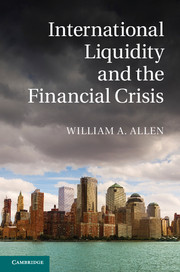The Bank of England
1950s to 1979
$59.99 ( ) USD
Part of Studies in Macroeconomic History
- Author: Forrest Capie, Cass Business School, UK
- Date Published: May 2011
- availability: This ISBN is for an eBook version which is distributed on our behalf by a third party.
- format: Adobe eBook Reader
- isbn: 9781139064965
Find out more about Cambridge eBooks
$
59.99 USD
( )
Adobe eBook Reader
Other available formats:
Hardback, Paperback
Looking for an examination copy?
If you are interested in the title for your course we can consider offering an examination copy. To register your interest please contact [email protected] providing details of the course you are teaching.
-
This history of the Bank of England takes its story from the 1950s to the end of the 1970s. This period probably saw the peak of the Bank’s influence and prestige, as it dominated the financial landscape. One of the Bank’s central functions was to manage the exchange rate. It was also responsible for administering all the controls that made up monetary policy. In the first part of the period, the Bank did all this with a remarkable degree of freedom. But economic policy was a failure, and sluggish output, banking instability, and rampant inflation characterized the 1970s. The pegged exchange rate was discontinued, and the Bank’s freedom of movement was severely constrained, as new approaches to policy were devised and implemented. The Bank lost much of its freedom of movement but also took on more formal supervision.
Read more- Comprehensive and authoritative history of the Bank of England across a period of turbulence
- Written accessibly with a wide audience in view
- The latest in a series of official histories of the Bank covering earlier periods published by Cambridge University Press
Reviews & endorsements
“Forrest Capie has written an invaluable work of impeccable historical scholarship. Not only do we now have a scrupulously researched and beautifully written history of the Bank of England from Attlee to Thatcher, a work of reference that all students of financial history will come to revere. We also gain some fascinating insights into the way an earlier generation grappled with the problems of financial regulation, inflation, asset bubbles, and banking crises.” – Niall Ferguson, Laurence A. Tisch Professor of History, Harvard University, and William Ziegler Professor, Harvard Business School
See more reviews“Outstanding scholarship . . . well written . . . and showing a fine independence of judgment.” – Lord Griffiths of Fforestfach
“Forrest Capie brings the sure hand of an economist to the task of describing the intellectual confusion that besieged the Bank of England as it tried to establish its role as a central bank responsible for easing the British economy through the difficult adjustments required between 1950 and 1979. But he also displays his talent as an historian in depicting the drama of the personal conflicts, compromises, and eventual triumphs that occurred within the leadership of the Bank as they confronted first the constraints of fixed exchange rates with capital controls while dealing with the demands of the Treasury, and then the collapse of both fixed exchange rates and capital controls in the 1970s. A compelling saga of the world’s oldest central bank as it tested various paths leading toward an effective role in financial globalization.” – Larry Neal, University of Illinois at Urbana-Champaign
“Forrest Capie provides what will certainly be the definitive account of the Old Lady of Threadneedle Street’s varying fortunes though the second third of the 20th century. The history is brought to life by its numerous portraits of the principal actors and its clear-eyed judgments on their work. A magnificent achievement.” – Robert Pringle, Founder and Chairman of Central Banking Publications
“A masterful, well-contextualised account of the Bank at the summit of its traditional responsibilities and the peak of its personnel. Authoritative and meticulous yet accessible and colourful, it is an indispensable addition to postwar financial and economic history. Along with forerunner volumes by Clapham, Sayers and Fforde, Capie’s study is destined to become a classic.” – Richard Roberts, Director, Centre for Contemporary British History, King's College, London
"Forrest Capie... has not only written a meticulously researched, scholarly account of the history of 'the Old Lady of Threadneedle Street' from Attlee to Thatcher, but he has produced a cogent analysis of how the bank managed the exchange rate and administered monetary policy controls before the banking instability and the raging inflation of the 1970s saw its powers curtailed. A potentially dry subject is enlivened by Mr Capie's insights on the personal conflicts and compromises among the bank's leaders as they grappled with the challenges of the day." - The Economist Intelligence Unit
"This thorough and interesting account is an indispensable reference for anyone who would understand the Bank of England, or more generally the theories, institutions, and politics of British economic policies before the changes that followed 1979." - John H. Wood, Wake Forest University, EH.net
Customer reviews
Not yet reviewed
Be the first to review
Review was not posted due to profanity
×Product details
- Date Published: May 2011
- format: Adobe eBook Reader
- isbn: 9781139064965
- contains: 53 b/w illus. 38 tables
- availability: This ISBN is for an eBook version which is distributed on our behalf by a third party.
Table of Contents
1. Introduction and overview
2. The Bank in the 1950s
3. The monetary setting and the Bank
4. The Bank's external responsibilities to 1964
5. From crisis to 'crucifixion'
6. Domestic monetary policy after Radcliffe
7. Other activities and performance
8. Sterling from devaluation to Smithsonian
9. The road to competition and credit control
10. Competition and credit control
11. The secondary banking crisis
12. Banking supervision
13. Monetary targets and monetary control
14. The Bank and sterling in the 1970s
15. The Bank's freedom to operate
16. Epilogue.
Sorry, this resource is locked
Please register or sign in to request access. If you are having problems accessing these resources please email [email protected]
Register Sign in» Proceed
You are now leaving the Cambridge University Press website. Your eBook purchase and download will be completed by our partner www.ebooks.com. Please see the permission section of the www.ebooks.com catalogue page for details of the print & copy limits on our eBooks.
Continue ×Are you sure you want to delete your account?
This cannot be undone.
Thank you for your feedback which will help us improve our service.
If you requested a response, we will make sure to get back to you shortly.
×







